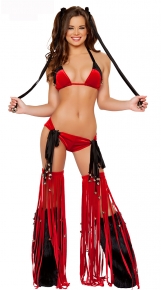Costumes – Fancy Dress or Otherwise
The classical interpretation or dictionary definition of a costume is a style of dressing including all clothes and accessories worn to portray a particular period of time or country. A Christmas costumes can be described as being a particular style of clothing and accessories worn to portray the wearer as a character, or persona, other than that which is normal for them.
Classically this applies to actors and their theatrical performances where costumes are used to transport the watcher to the historical period or geographical location of the character being played. Within the theater, costumes are used to convey visual cues to the watching audience on details of the character’s age, social standing/class and profession. This is in addition to the major attributes of geographical location and chronological period. Theatrical costumers often invent/develop stylized costumes to exaggerate some aspect of the character wearing the costume – for example, consider the highly stylized costume of exaggerated shoulders and lapels of a sharply tailored black jacket with a thick white pin-striping and you have a classic cartoon gangster……
When the costumes are accurate and correctly detailed, these visual costume cues allow the theatre/opera goer to better context characters to each other and to the overall theatrical piece. Applause then, for both the theatrical costumer and costume designer.\
Outside of the acting profession costumes are worn in-order to either change our character, or at least give us the ability to change our character, at events such as a masquerade, fancy dress ball or Mardi Gras celebration or are worn to in-order that we can celebrate our own heritage. In the case of the latter, this would be the wearing of a costume that is other than the norm where the costume will represent a national or religious uniqueness (heritage), for example, Scots and kilts, Japanese and kimonos, Rastafarians and dreadlocks. Here, costume will be very much related to both clothes and accessories, where ‘accessories’ includes other elements like the hair style adopted. Today this challenge is meet through the wearing of wigs or false mustaches and beards; whether these ‘costumes’ are present or not, they are what we use as a visual stylization ideal for that ‘group’. There must also be a point of saturation where the uniqueness of costume gives way to normality……..
As the wearing of a Christmas costumes allows the wearer the ability to change persona, at least for the time that the costume is being worn, fancy dress costumes and fancy dress parties have become more popular. The wearing of fancy dress costumes remains an important part of Halloween and Mardi Gras but nowadays, costumes are being worn during other fixed calendar celebrations such as Christmas and New Years with other non date specific celebrations like Hen and Stag Nights also proving popular times for the anonymity that fancy dress offers – although perversely it appears that it is the attention that the fancy dress brings which is the primary driver to the wearer………
Other examples of secular holidays or celebrations where fancy dress are commonly used to portray specific characters would include; Valentines Day (Cupid or Eros) and US Independence Day (Uncle Sam). Increasingly, the Saints days for St Patrick and St George are being seen as occasions for the donning of fancy dress (and celebrating).
So as you can see, there are a great many occasions suited to the wearing of costumes, but no matter what the occasion the basic premise for wearing it will be to allow the wearer the ability to change persona no matter for how short a period of time.